# Beasts
The animals listed below are those that feature as foes in stories of the horror genre (think of Hitchcock’s The Birds) or those that might be utilized by the investigators (such as horses as mounts).
# Bat, Large
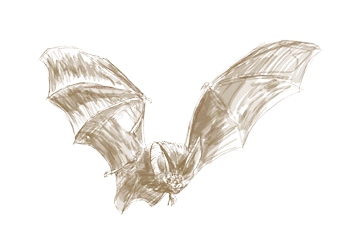
The giant fruit bat of Central America congregates in dozens or hundreds. The smaller bats common to the United States gather in enormous cavern-based flocks of up to 50,000 individuals. Bats worldwide are under severe environmental attack from humans.
# Bat, Large
| Characteristic | Average | Rolls |
|---|---|---|
| STR | 25 | (2D4) ×5 |
| CON | 35 | (2D6) ×5 |
| SIZ | 15 | (2D4) ×5 |
| DEX | 105 | (1D6+18) ×5 |
| POW | 35 | (2D6) ×5 |
If attacking as a group, use the characteristics above to represent the group, increasing the Size by 10 and damage dice size by 1 for each additional bat.
HP: 5
Average Damage Bonus: -2
Average Build: –2
Move: 1 / 12 flying
# Attacks
Attacks per round: 1
Fighting attacks: Attacks with teeth and claws.
Fighting attacks (Group): Each time the target beats the bats in a Fighting roll reduce the number of bats by one. Thus a group of 6 bats would have a size of 65 and would inflict 1D6 damage (since there isn’t a D7).
Fighting 40% (20/8) damage 1D2 (+1 to dice size per extra bat in group)
Dodge 52% (26/10)
Armor: None.
Skills: Spot Hidden (echo-locate) 75%.
Habitat: Warm and temperate climates worldwide.
# Bears
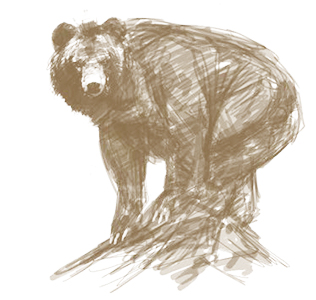
The Black bear is by far the most common type of bear in North America. It is the only bear likely to be met in the eastern United States.
# Bear, Black
| Characteristic | Average | Rolls |
|---|---|---|
| STR | 100 | (3D6+10) ×5 |
| CON | 65 | (2D6+6) ×5 |
| SIZ | 100 | (3D6+10) ×5 |
| DEX | 50 | (3D6) ×5 |
| POW | 50 | (3D6) ×5 |
HP: 16
Average Damage Bonus: +2D6
Average Build: 3
Move: 12
# Attacks
Attacks per round: 2
Fighting attacks: Large strong creatures with big paws, claws and
teeth.
Fighting 40% (20/8), damage 1D6 + damage bonus
Dodge 25% (12/5)
Armor: 3-point fur and gristle.
Skills: Climb 30%, Listen 75%, Scent Prey 70%
Habitat: Southern Canada to Southern Mexico.
# Crocodile
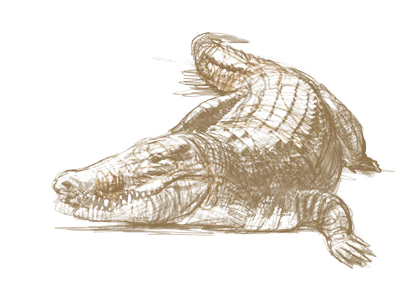
The Nile crocodile, now rare in the lower Nile but still found in central Africa, Madagascar, tropical Asia and northern and western Australia. Where there is water there may be crocodiles. Crocs eat anything they can catch and come in great numbers to a kill to feed communally. Usually they will not attack a boat. Similar stats may be used for any crocodilia, including alligators, caimans, and gavials—all long-snouted, lizard-like, and carnivorous.
# Crocodile, Nile
| Characteristic | Average | Rolls |
|---|---|---|
| STR | 130 | (4D6+12) ×5 |
| CON | 90 | (3D6+8) ×5 |
| SIZ | 130 | (4D6+12) ×5 |
| DEX | 35 | (2D6) ×5 |
| POW | 50 | (3D6) ×5 |
HP: 22
Average Damage Bonus: +2D6
Average Build: 3
Move: 6 / 8 swimming
# Attacks
Attacks per round: 1
Fighting attacks: The main danger of course is their bite, but a large one can thrash around and cause impact damage.
Bite and hold (mnvr): Vicious jaws; once they have hold they are unlikely to let go and may drag their victim underwater to drown.
Fighting 50% (25/10), damage bonus
Bite and hold (mnvr) damage 1D10 + damage bonus, followed by damage bonus each round while held (or drowning)
Dodge 17% (8/3)
Armor: 5-point hide.
Skills: Stealth 60% (in water 80%)
Habitat: Tropics, especially jungle marshes worldwide.
# Dog

Our domestic friends are notable among animals for devotion and affection to their human masters. As hunters, they prefer to gather in packs of 1D8+3 animals minimum. Dogs come in a variety of sizes and the (average) values below should be adapted accordingly.
# Dog
| Characteristic | Average | Rolls |
|---|---|---|
| STR | 35 | (2D6) ×5 |
| CON | 50 | (3D6) ×5 |
| SIZ | 35 | (2D6) ×5 |
| DEX | 70 | (4D6) ×5 |
| POW | 35 | (2D6) ×5 |
HP: 8
Average Damage Bonus: -1
Average Build: –1
Move: 12
# Attacks
Attacks per round: 1
Fighting 50% (25/10), damage 1D6
Dodge 42% (21/8)
Armor: N/A
Skills: Listen 75%, Scent Something Interesting 90%.
Habitat: Where humans live.
# Horse
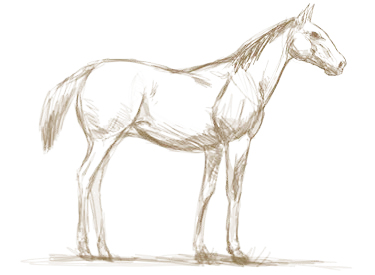
Horses offer many advantages to those who know their ways. For roleplaying, divide them into riding horses, draught horses, donkeys, and mules.
Use of the riding horse is covered by the Ride skill. Single riders and small groups can easily cover forty miles in a day, given plenty of water and fodder, such as oats and other grains. Riding horses may spar with other horses, but they do not fight unless cornered. Even cavalry-trained horses are trained merely to stay their ground and control their nervousness. Nearly all horses will panic at the presence of some supernatural thing.
Draught horses are the largest of horses, usually broken to ride but not much ridden. To hitch them to wagons, a Drive Horses or similar roll might be asked. Saddles and girths large enough for them may not exist; bareback riding could be done with one penalty die to the Ride skill. Donkeys and mules mostly carry burdens, not riders, or draw wagons or carts. Stereotypically, they ignore commands when it pleases them, even brutal ones.
Among all horses, the tendency concerning bloody events, gunfire, monsters, angry crowds and so on, will be a sensible one, to flee.
# Horse
| Characteristic | Average | Rolls |
|---|---|---|
| STR | 140 | (3D6+18) ×5 |
| CON | 65 | (2D6+6) ×5 |
| SIZ | 165 | (6D6+12) ×5 |
| DEX | 50 | (3D6) ×5 |
| POW | 50 | (3D6) ×5 |
HP: 23
Average Damage Bonus: +3D6
Average Build: 4
Move: 12
# Attacks
Attacks per round: 1
Fighting attacks: These are large animals that can kick and bite as well as buffet a lesser opponent to the ground. Can rise up on its hind legs then plunge down with its forelegs. A horse requires training for it to trample people.
Fighting 25% (12/5), damage 1D8 + damage bonus
Dodge 25% (12/5).
Armor: None.
Habitat: Grasslands and high deserts, or where humans are.
# Rat
Individual rats are not worthy opponents, but an infestation of rats can be daunting. Assume ten rats per pack. A successful attack by an investigator kills one or two rats and usually chases away the rest of that pack.
Rack Pack
| Characteristic | Average | Rolls |
|---|---|---|
| STR | 35 | (1D6+4) ×5 |
| CON | 55 | (2D6+4) ×5 |
| SIZ | 35 | (1D6+4) ×5 |
| DEX | 70 | (4D6) ×5 |
| POW | 50 | (3D6) ×5 |
HP: 9
Average Damage Bonus: -1
Average Build: –1
Move: 9
# Attacks
Attacks per round: 1
Fighting attacks: Rats attack with teeth and claws.
Overwhelm (mnvr): As a pack they may assault and overwhelm an individual using the maneuver rules, because of their numbers
they gain one bonus die on the attack. Such an attack would involve swarming over the target, biting and scratching as they do so.
Fighting 40% (20/8), damage 1D3
Overwhelm (mnvr) damage 2D6
Dodge 42% (21/8)
Armor: N/A
Habitat: Not far from where you are sitting right now.
# Wasp and Bee Swarms
A cloud of stinger-equipped, flying insects attacks for 2D6 combat rounds before halting pursuit. Unless the victims are completely covered (as with netting or by being enclosed in an automobile or by diving underwater), there is no protection against them. An investigator who is stung extensively and whose player fails a CON roll may experience profound immune system shock, fall seriously ill, and (rarely) die. The Africanized bees presently colonizing the Americas are more intent in their pursuit than are honey bees or wasps, attacking for up to 3D6 minutes. Being seriously stung by these so-called killer bees occasionally results in death, since the attacks are comparatively unrelenting and often more numerous. Each minute of such attack might cost as much as 1D6 hit points.
# Wolf
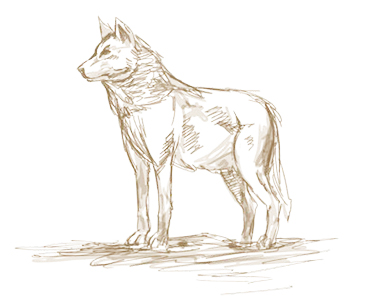
They may hunt in packs when dogging herds of elk or caribou; they as often hunt singly or in family pairings. Wolves are normally shy and verified attacks on healthy humans are said to be rare or non-existent.
# Wolf
| Characteristic | Average | Rolls |
|---|---|---|
| STR | 65 | (2D6+6) ×5 |
| CON | 50 | (3D6) ×5 |
| SIZ | 40 | (2D6+1) ×5 |
| DEX | 65 | (2D6+6) ×5 |
| POW | 50 | (3D6) ×5 |
HP: 9
Average Damage Bonus: none
Average Build: 0
Move: 12
# Attacks
Attacks per round: 1
Fighting attacks: Teeth, claws and mauling.
Fighting 50% (25/10), damage 1D8 + damage bonus
Dodge 32% (16/6)
Armor: 1-point fur
Skills: Track (by smell) 90%, Spot Hidden 60%
Habitat: Approximately the same ranges as larger cold and temperate climate ruminants and herbivores.